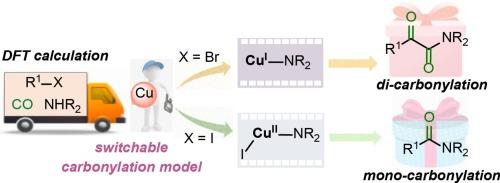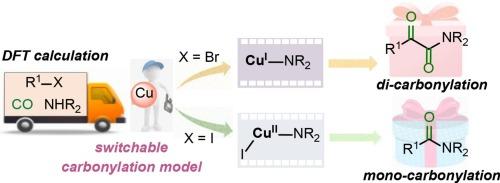价转换模型中多重羰基化的DFT研究
IF 6.5
1区 化学
Q2 CHEMISTRY, PHYSICAL
引用次数: 0
摘要
本报告描述了过渡金属催化的可切换羰基化模型,使选择性羰基化反应。研究了铜(I)催化的单/二羰基化反应,以验证所提出的模型。机制研究表明,低价金属中心捕获CO分子以提供相应的金属酰基。然后,氧化电位较弱的烷基溴通过卤素原子转移与金属酰基发生反应,生成酰基自由基,生成二羰基化产物。或者,在具有更强氧化电位的碘化烷基存在下,低价金属中心优先被氧化成高价价,同时只产生单羰基化产物。最后,基于绝对定域分子轨道的能量分解分析和变分正反向分析揭示了所观察到的化学选择性的来源。本文章由计算机程序翻译,如有差异,请以英文原文为准。


DFT study on multi-carbonylation in a valence-switchable model
This report describes a transition metal-catalyzed switchable carbonylation model that enables selective carbonylation reactions. Mono-/dicarbonylation reactions catalyzed by copper(I) are investigated to validate the proposed model. Mechanistic studies indicate that a low-valent metal center captures a CO molecule to afford the corresponding metal-acyl species. Then, the alkyl bromide, with a weak oxidation potential, reacts with the metal-acyl species via halogen atom transfer, which generates an acyl radical species, leading to the dicarbonylation product. Alternatively, in the presence of alkyl iodide, which has a stronger oxidation potential, the low-valent metal center is preferentially oxidized to higher valence, with concomitant generation of only the monocarbonylation product. Finally, energy decomposition analysis based on absolutely localized molecular orbitals and variational forward–backward analysis reveals the origin of the observed chemoselectivity.
求助全文
通过发布文献求助,成功后即可免费获取论文全文。
去求助
来源期刊

Journal of Catalysis
工程技术-工程:化工
CiteScore
12.30
自引率
5.50%
发文量
447
审稿时长
31 days
期刊介绍:
The Journal of Catalysis publishes scholarly articles on both heterogeneous and homogeneous catalysis, covering a wide range of chemical transformations. These include various types of catalysis, such as those mediated by photons, plasmons, and electrons. The focus of the studies is to understand the relationship between catalytic function and the underlying chemical properties of surfaces and metal complexes.
The articles in the journal offer innovative concepts and explore the synthesis and kinetics of inorganic solids and homogeneous complexes. Furthermore, they discuss spectroscopic techniques for characterizing catalysts, investigate the interaction of probes and reacting species with catalysts, and employ theoretical methods.
The research presented in the journal should have direct relevance to the field of catalytic processes, addressing either fundamental aspects or applications of catalysis.
 求助内容:
求助内容: 应助结果提醒方式:
应助结果提醒方式:


